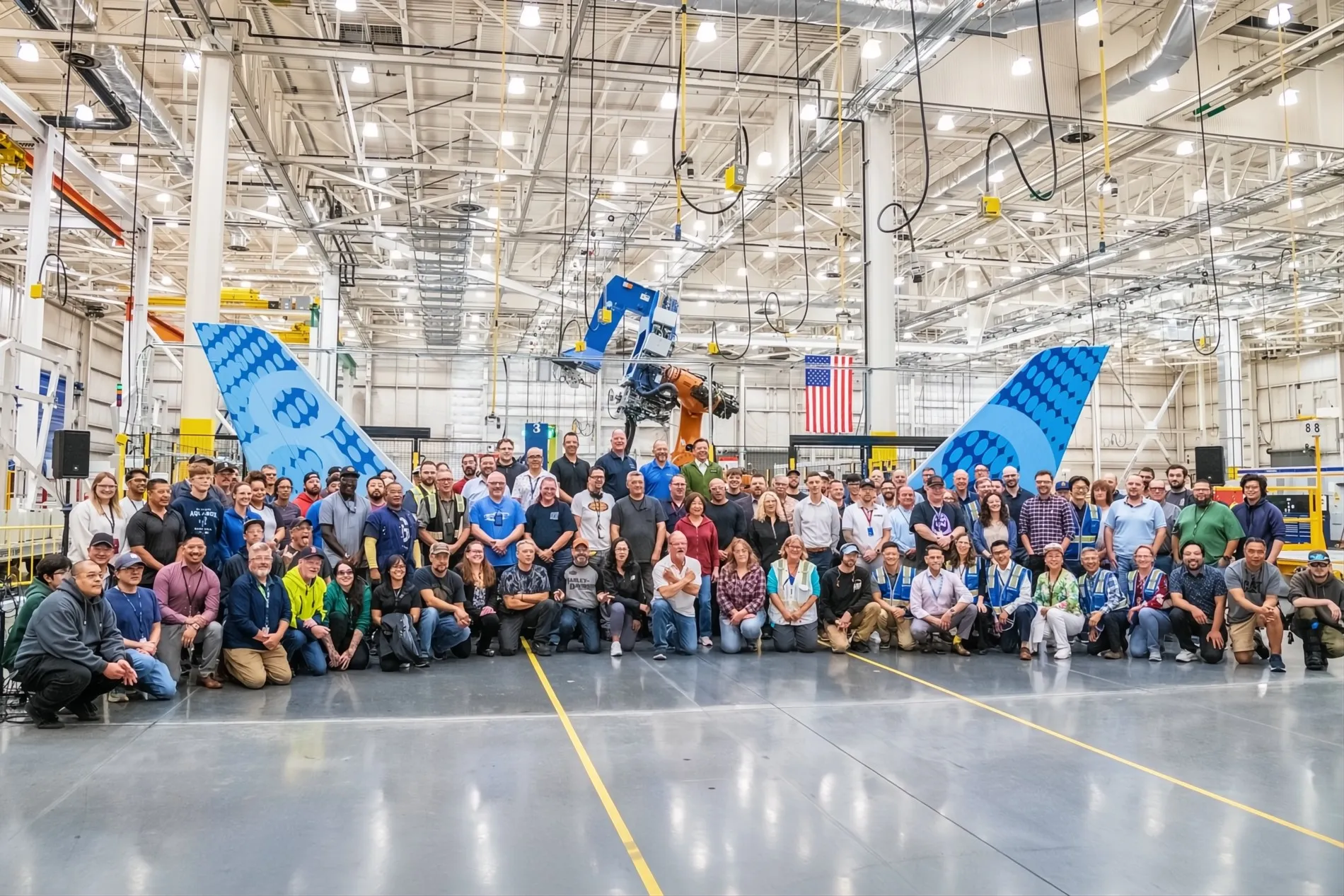EVERETT — Boeing and its global partners marked a pivotal moment this week as the first spar for the 777‑8 Freighter was officially drilled into production at the Composite Wing Centre in Everett, as announced by Boeing News Now.
Spars – the long, load-bearing beams – are the structural backbone of the wings. At 108 feet (32.9 m), this inaugural spar signals Boeing’s move toward assembling the wings for its newest twin‑engine cargo jet.
Simultaneously, skin panels and stringers, which are essential components for wing strength and shape, have already been produced at both Everett and strategic supplier sites in Japan, including Mitsubishi Heavy Industries, Kawasaki Heavy Industries, and Subaru.
Automated Precision at Work
Guided by Boeing’s seasoned technicians and precision-driven Automated Fiber Placement (AFP) machines, layers of composite material are methodically laid and stitched before the drilling process begins. With steady hands, Casey McDowell took the controls and drilled the very first hole into the 777-8 Freighter’s wing spar. The result is a flawless fusion of human skill and automation, shaping the structural heart of what’s set to become the world’s most capable twin-engine freighter.
As Boeing stated on its official X account:
“Today, our team officially started production on the first 777‑8 Freighter with the drilling of the initial spar. The 108‑foot spars, ...”
Sharing Happy Moments
For Robin Thorning, automation manager and a Boeing veteran of 38 years, drilling the first hole into the wing spar was more than just another milestone; it was a personal moment.
“I helped build the very first 777 – WA001 – early in my career, and it’s exciting to get to start our newest member of the 777X family.”
With his family collectively contributing nearly a century of service to Boeing, Thorning described the experience as a privilege, calling it “a once-in-a-lifetime opportunity” to help bring such aircraft to life. His reflection underscores the sense of legacy and pride embedded in the 777-8 Freighter program.
Design Phase Nearly Complete
Boeing engineers have finalised more than 80% of the drawings defining the 777‑8F’s configuration. Design teams continue refining detailed systems and components, while rigorous lab testing is verifying performance ahead of assembly.
Dan Truong, the Composite Wing Center’s process leader, expressed optimism:
“We’re excited to be building wings for the new freighter and see this program succeed. I’m looking forward to seeing the airplane fly, knowing we contributed.”
Ben Linder, chief project engineer for the 777/777‑8F, emphasised Boeing’s freighter market dominance:
“Customers have a definite preference to choose Boeing – Boeing’s family of freighters serve 90% of the global freighter market.”
Next Milestones & Delivery Timeline
- Wing assembly progression has begun in Japan, with Japanese partners manufacturing center sections and keel beams.
- The first flight of the 777‑8F is anticipated in 2026, with entry into service targeted in 2028.
- Boeing’s Current Market Outlook forecasts a 65% increase in the large widebody freighter fleet by 2044, comprising approximately 885 new aircraft, with the 777-8F positioned to lead that growth.
Why the 777‑8F Matters
Derived from the advanced 777X family, the 777‑8F moves the world of freight into a new era (the table below refers to the official data shared by Boeing):
Feature Summary
- Payload
- 118.2 tonnes Structural Payload (260,524 lbs)
- 112.3 tonnes Revenue Payload (247,570 lbs) (matching the iconic 747‑400F)
- Range
- Approximately 4,410 nautical miles (~8,167 km) at maximum payload
- Efficiency Gains
- ~30% less fuel burn
- ~25% lower operating cost per tonne
- ~60% quieter noise footprint
- Engines & Technology
- Powered by next-generation GE9X engines
- Composite wings
- Fly-by-wire systems
- 787-style avionics
- Cargo Setup
- 31 main-deck pallets
- Offers 17% more volume than today’s 777-F
- Designed to ship bulkier freight more efficiently
In short, the 777-8F combines industry-leading capacity, long-haul flexibility, and next-generation sustainability, positioning it as Boeing’s freighter solution for a growing, eco-conscious cargo market that demands more payload, cleaner skies, and improved economics.
A Freight Revolution in the Making
Since its launch in 2022, the 777-8F has garnered strong market interest, with 59 confirmed orders from launch customers, including Qatar Airways Cargo (QTR), FedEx (FDX), DHL (DHL), and Etihad (ETD). Its dual-pillar strategy, focusing on sustainability and economics, supports airlines in reducing emissions, cutting operating costs, and meeting stringent noise regulations.
This new freighter offers airlines and airports a pathway into a greener, quieter future, and its production milestone marks the beginning of a fresh generation for air cargo.
Following Milestones & Delivery Timeline
- Wing assembly progression has begun in Japan, with Japanese partners manufacturing center sections and keel beams.
- The first flight of the 777-8F is anticipated in 2026, with entry into service targeted for 2028, replacing retiring fleets such as the 747-400F.
- Boeing’s Current Market Outlook forecasts a 65% increase in the large widebody freighter fleet by 2044, comprising approximately 885 new aircraft, with the 777-8F positioned to lead that growth.
Bottom Line
Boeing’s move into 777‑8 Freighter production is more than a manufacturing achievement; it’s a statement. It states that the future of freight hinges on advanced composites, global collaboration, and efficiency-driven technology. Behind each carbon-fiber wing panel lies the promise of clean skies and more innovative logistics.
This week, as the spar was drilled and the wings began to take shape, the future of air cargo quietly but unmistakably took flight.
Stay tuned and keep following Airways. Follow us on LinkedIn and Instagram for the latest updates as well!



.webp)
